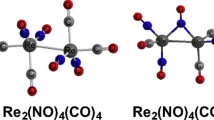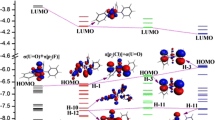Abstract
Homoleptic mononuclear and binuclear ruthenium carbonyls Ru(CO) n (n = 3–5) and Ru2(CO) n (n = 8,9) have been investigated using density functional theory. Sixteen isomers are obtained. For Ru(CO)5, the lowest-energy structure is the singlet D 3h trigonal bipyramid. Similar to Os(CO)5, the distorted square pyramid isomer with C 2v symmetry lies ∼7 kJ·mol−1 higher in energy. For the unsaturated mononuclear ruthenium carbonyls Ru(CO)4 and Ru(CO)3, a singlet structure with C 2v symmetry and a C s bent T-shaped structure are the lowest-energy structures, respectively. The global minimum for the Ru2(CO)9 is a singly bridged (CO)4Ru(μ-CO)Ru(CO)4 structure. A triply bridged Ru2(CO)6(μ-CO)3 structure analogous to the known Fe2(CO)9 structure is predicted to lie very close in energy to the global minimum. For Ru2(CO)8, the doubly bridged C 2 structure is predicted to be the global minimum. For the lowest-energy structures of M2(CO) n (M = Fe, Ru, Os, n = 9,8), it is found that both iron and ruthenium are favored to form structures containing more bridging carbonyl groups, while osmium prefers to have structures with less bridging carbonyl groups. The study of dissociation energy shows that the dissociation of Ru2(CO)9 into the mononuclear fragments Ru(CO)5 + Ru(CO)4 is a less energetically demanding process than the dissociation of one carbonyl group from Ru2(CO)9 to give Ru2(CO)8.
Similar content being viewed by others
References
Calderazzo F, L’Eplattenier F. The pentacarbonyls of ruthenium and osmium. Inorg Chem, 1967, 6(6): 1220–1224
Rushman P, Van Buuren G N, Shiralian M, Pomeroy R K. Properties of the pentacarbonyls of ruthenium and osmium. Organometallics, 1983, 2(5): 693–694
Gregory M F, Poliakoff M, Turner J J. Infrared spectra of 13CO- enriched Ru(CO)5 in liquid xenon: The energy-factored force field. J Mol Struct, 1985, 127(3–4): 247–256
Huang J, Hedberg K, Davis H B, Pomeroy R K. Structure and bonding in transition-metal carbonyls and nitrosyls. 4. Molecular structure of ruthenium pentacarbonyl determined by gas-phase electron diffraction. Inorg Chem, 1990, 29(20): 3923–3932
Zhou M, Andrews L. Infrared spectra and density functional calculations of RuCO+, OsCO+, Ru(CO)x, Os(CO)x, Ru(CO) −x and Os(CO) −x (x = 1–4) in solid neon. J Phys Chem A, 1999, 103(35): 6956–6968
Decker S A, Klobukowski M. The first carbonyl bond dissociation energies of M(CO)5 and M(CO)4(C2H2) (M = Fe, Ru, and Os): the role of the acetylene ligand from a density functional perspective. J Am Chem Soc, 1998, 120(36): 9342–9355
Hastings W R, Baird M C. A new form of ruthenium tetracarbonyl. Inorg Chem, 1986, 25(16): 2913–2915
Ziegler T, Tschinke V, Fan L, Becke A D. Theoretical study on the electronic and molecular structures of (C5H5)M(L) (M = Rh, Ir; L = CO, PH3) and M(CO)4 (M = Ru, Os) and their ability to activate the C-H bond in methane. J Am Chem Soc, 1989, 111(26): 9177–9185
Bogdan P L, Weitz E. A transient infrared spectroscopy study of coordinatively unsaturated ruthenium carbonyls. J Am Chem Soc, 1989, 111(9): 3163–3167
Corey E R, Dahl L F. Trinuclear osmium and ruthenium carbonyls and their identities with previously reported Os2(CO)9 and Ru2(CO)9. J Am Chem Soc, 1961, 83(9): 2203–2204
Churchill M R, Hollander F J, Hutchinson J P. An accurate redeter- mination of the structure of triruthenium dodecacarbonyl, Ru3(CO)12. Inorg Chem, 1977, 16(10): 2655–2659
Moss J R, Graham W A G. The enneacarbonyls of ruthenium and osmium. Dalton Trans, 1977, 95–99
Grevels F W, Klotzbucher W E, Schrickel J, Schaffner K. Short-Wavelength flash photolytic fragmentation of Ru3(CO)12 in the presence of CO and complementary experiments with Ru(CO)5: a time-resolved IR spectroscopic study. J Am Chem Soc, 1994, 116(14): 6229–6237
Hunstock E, Mealli C, Calhorda M J, Reinhold J. Molecular structures of M2(CO)9 and M3(CO)12 (M = Fe, Ru, Os): new theoretical insights. Inorg Chem, 1999, 38(22): 5053–5060
Kabira S E, Hogarth G, The chemistry of [M3(CO)10(µ-dppm)](M = Ru, Os): Activating and maintaining the trinuclear core. Coord Chem Rev, 2009, 253: 1285–1315
Therrien B, Georg S-F. Sawhorse-type diruthenium tetracarbonyl complexes. Coord Chem Rev, 2009, 253: 2639–2664
Luo Q, Li Q S, Yu Z H, Xie Y M, King R B, Schaefer H F. Bonding of seven carbonyl groups to a single metal atom: theoretical study of M(CO)n (M = Ti, Zr, Hf; n = 7, 6, 5, 4). J Am Chem Soc, 2008, 130(24): 7756–7765
Becke A D. Density-functional exchange-energy approximation with correct asymptotic behavior. Phys Rev A, 1988, 38: 3098–3100
Perdew J P. Density-functional approximation for the correlation energy of the inhomogeneous electron gas. Phys Rev B, 1986, 33: 8822–8824
Adamo C, Barone V. Exchange functionals with improved long-range behavior and adiabatic connection methods without adjustable parameters: The mPW and mPW1PW models. J Chem Phys, 1998, 108(2): 664–675
Dolg M, Stoll H, Preuss H. A combination of quasirelativistic pseudopotential and ligand field calculations for lanthanoid compounds. Theor Chim Acta, 1993, 85(6): 441–450
Andrae D, Haußermann U, Dolg M, Preuß H. Energy-adjusted ab initio pseudopotentials for the second and third row transition elements. Theo Chim Acta, 1990, 77(2): 123–141
Dunning T H. Gaussian basis functions for use in molecular calculations. I. contraction of (9s5p) atomic basis sets for the first-row atoms. J Chem Phys, 1970, 53(7): 2823–2833
Huzinaga S. Gaussian-Type functions for polyatomic systems. I. J Chem Phys, 1965, 42(4): 1293–1302
Frisch M J, Trucks G W, Schlegel H B, Scuseria G E, Robb M A, Cheeseman J R, Zakrzewski V G, Montgomery Jr J A, Stratmann R E, Burant J C, Dapprich S, Millam J M, Daniels A D, Kudin K N, Strain M C, Farkas O, Tomasi J, Barone V, Cossi M, Cammi R, Mennucci B, Pomelli C, Adamo C, Clifford S, Ochterski J, Petersson G A, Ayala P Y, Cui Q, Morokuma K, Malick D K, Rabuck A D, Raghavachari K, Foresman J B, Cioslowski J, Ortiz J V, Baboul A D, Stefanov B B, Liu G, Liashenko A, Piskorz P, Komaromi I, Gomperts R, Martin R L, Fox D J, Keith T, Al-Laham M A, Peng C Y, Nanayakkara A, Gonzalez C, Challacombe M, Gill P M W, Johnson B, Chem W, Wong M W, Andres J L, Gonzalez C, Head-Gordon M, Replogle E S, Pople J A. Gaussian 03. Pittsburgh: Gaussian Inc, 2003
Feng X J, Gu J D, Xie Y M, King R B, Schaefer H F. Homoleptic carbonyls of the second-row transition metals: evaluation of hartree? fock and density functional theory methods. J Chem Theor Comput, 2007, 3(4): 1580–1587
Xu B, Li Q S, Xie Y M, King R B, Schaefer H F. Homoleptic mononuclear and binuclear osmium carbonyls Os(CO)n (n = 3–5) and Os2(CO)n (n = 8, 9): comparison with the iron analogues. Inorg Chem, 2008, 47(9): 3869–3878
Peng B, Li Q S, Xie Y M, King R B, Schaefer H F. Unsaturated trinuclear ruthenium carbonyls: large structural differences between analogous carbonyl derivatives of the first, second, and third row transition metals. Dalton Trans, 2008: 6977–6986
Xie Y M, King R B, Schaefer H F. Binuclear homoleptic iron carbonyls: incorporation of formal iron-iron single, double, triple, and quadruple bonds, Fe2(CO)x (x = 9, 8, 7, 6). J Am Chem Soc, 2000, 122(36): 8746–8761
Jiang F, Jenkins H A, Biradha K. Davis H B, Pomeroy R K, Zaworotko M J. Compounds with unbridged dative metal-metal bonds of formula (R3P)2 (OC)3OsW (CO)5 and related complexes, Organometallics, 2000, 19(24): 5049–5062
Fletcher S C, Poliakoff M, Turner J J. Structure and reactions of Fe2(CO)8: an IR spectroscopic study using 13CO, photolysis with plane-polarized light and matrix isolation. Inorg Chem, 1986, 25(20): 3597–3604
Hoffmann R. Building bridges between inorganic and organic chemistry. Angew Chem Int Ed Eng, 1982, 21(10): 711–724
Haynes A, Poliakoff M, Turner J J. The photochemistry of dinuclear osmium carbonyl complexes; characterisation of Os2(CO)8 using matrix isolation. J Organomet Chem, 1990, 383(1–3): 497–519
Author information
Authors and Affiliations
Corresponding author
Additional information
Supported by the National Natural Science Foundation of China (Grant Nos. 20873045 and 20973066)
Rights and permissions
About this article
Cite this article
Peng, B., Gu, F., Zhang, X. et al. Theoretical study on homoleptic mononuclear and binuclear ruthenium carbonyls Ru(CO) n (n= 3–5) and Ru2(CO) n (n = 8, 9). Sci. China Ser. B-Chem. 52, 1938–1944 (2009). https://doi.org/10.1007/s11426-009-0283-9
Received:
Accepted:
Published:
Issue Date:
DOI: https://doi.org/10.1007/s11426-009-0283-9




